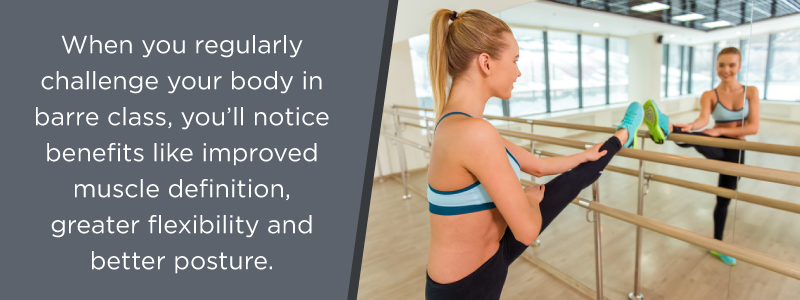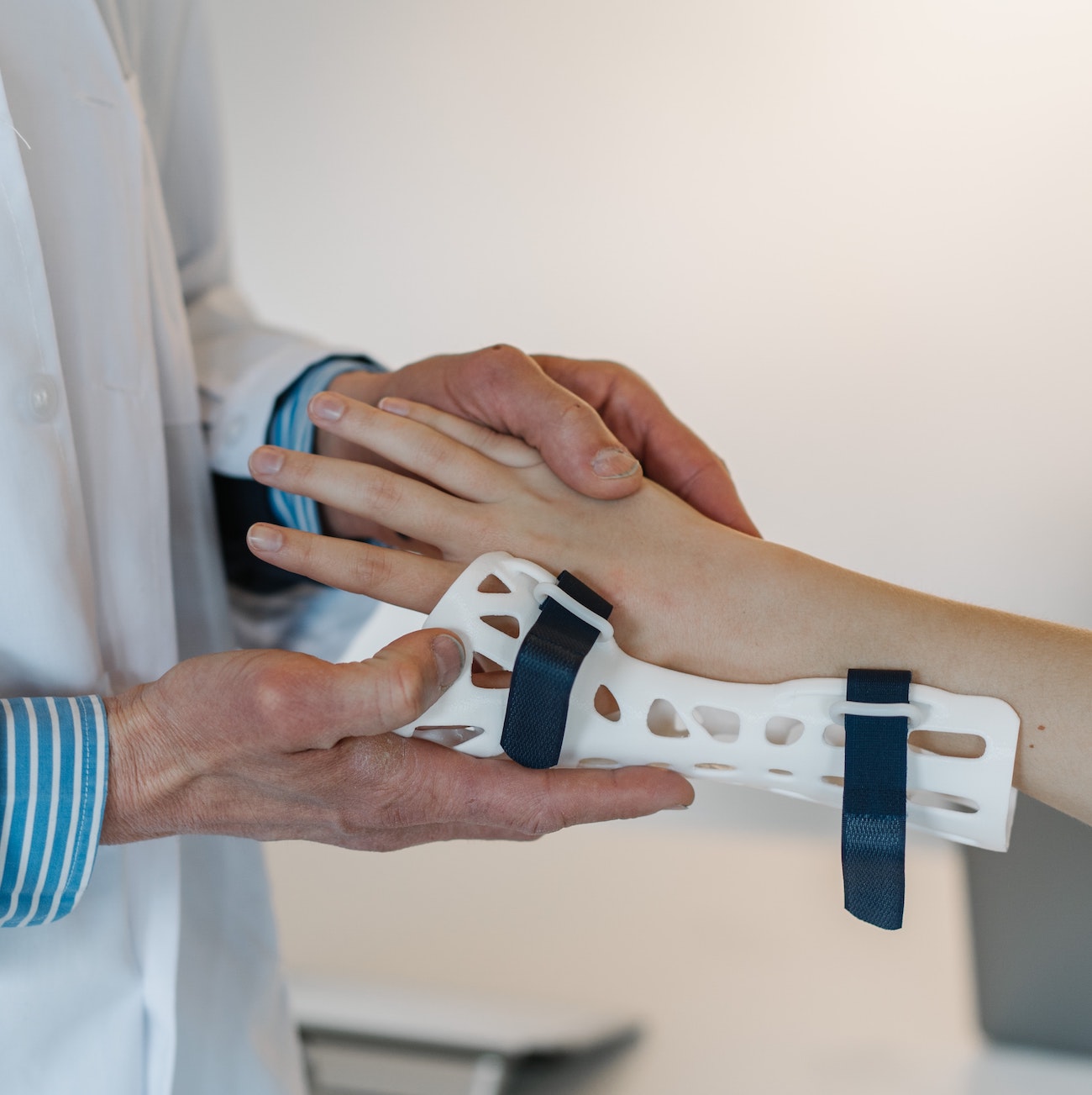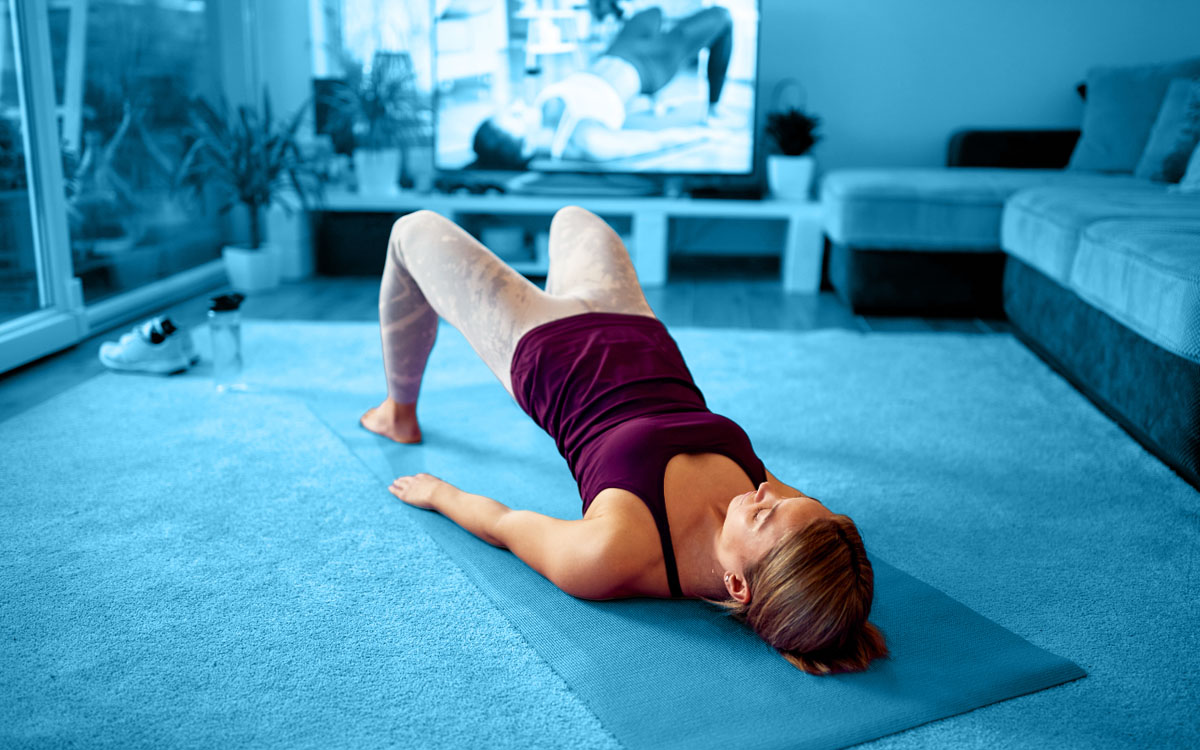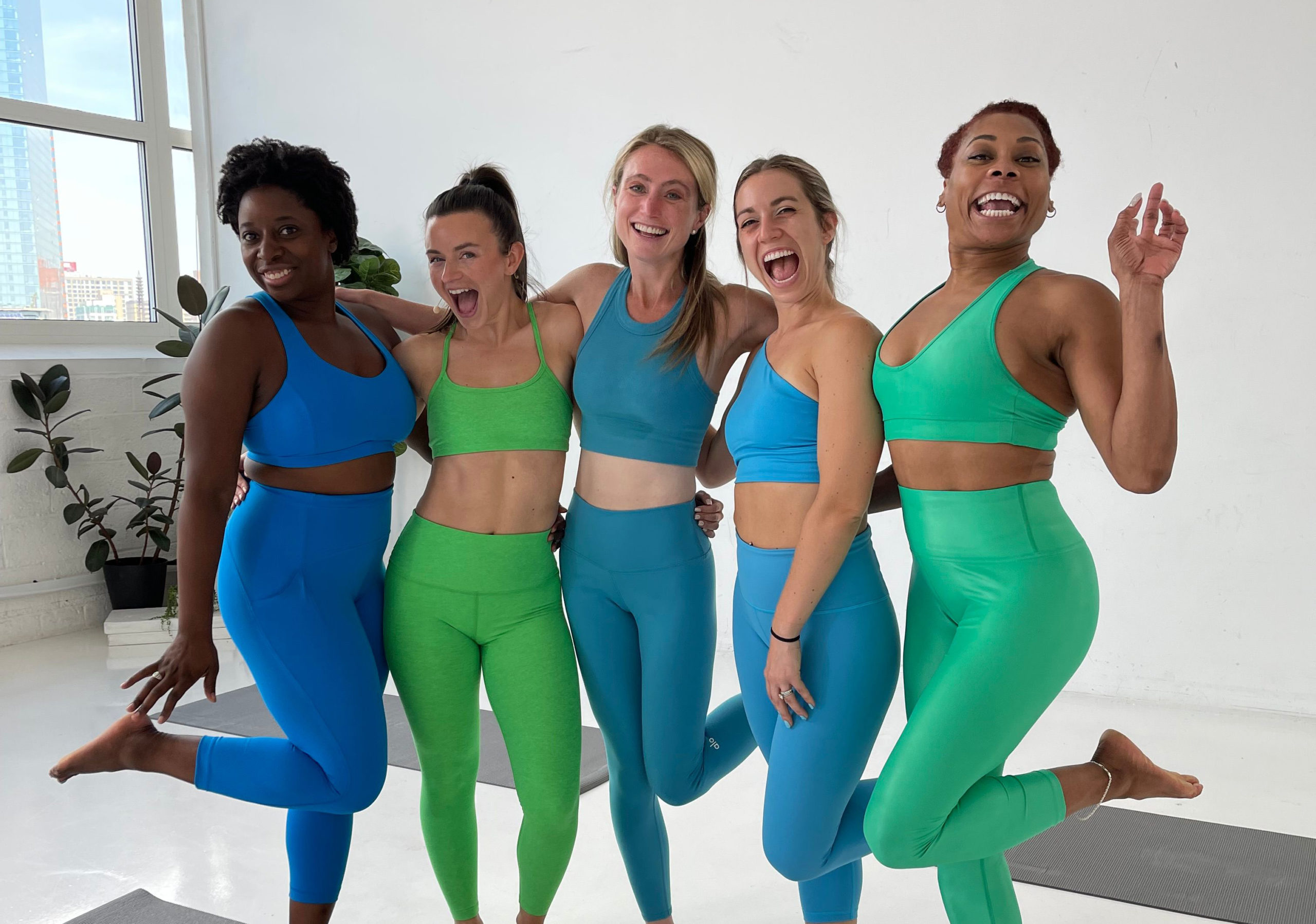Barre class is a rigorous workout that blends elements from different exercise styles including ballet, pilates, and yoga. Combining so many different challenging workouts can seem intimidating. How will you know what to do with your body? What are the different pieces of equipment? Take a deep breath. Most barre classes welcome first-timers, and your instructor will use hands-on guidance to help you get used to moving your body in new ways.
Barre class is named for the primary piece of equipment: the bar. If you’ve ever been in a ballet studio, this piece of equipment will be familiar. You’ll also use other equipment, like a mat — which you’re familiar with if you’ve ever tried yoga — or free weights, exercise bands and exercise balls. You can pick how heavy you want your weights to be, and your instructor will walk you through the proper use of each piece of equipment. They’ll explain how you can integrate the equipment into the class to get the best workout possible.
Getting the best workout possible means you’re going to be working a lot of different muscle groups. You can expect barre class to address multiple areas of your body, including your:
- Arms
- Legs
- Core
- Glutes
The exercises are set at a slow pace that aims to build strength and flexibility — you won’t have to worry about high impact moves, like jumping.
First Barre Class: What to Expect
Barre class might push you to your limits, but you can expect to gain a lot from dedicating yourself to the class. When you regularly challenge your body in barre class, you’ll notice benefits like improved muscle definition, greater flexibility and better posture. Like other types of regular exercise, barre can also help you manage and reduce your stress levels.
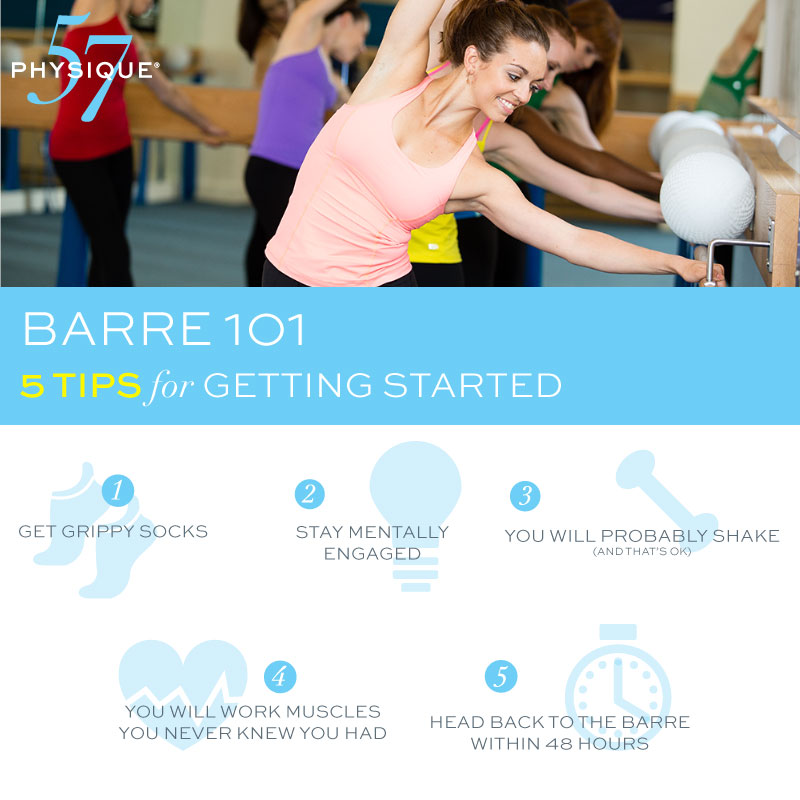
Now that you know the basics how of a barre class works here are five things to know before you dive in and take your first barre class:
1. What to Wear to Barre Class
What to wear to barre class depends a lot on your personal taste. It’s important to be comfortable during an exercise, so you shouldn’t feel the need to impress anyone with your barre outfit. Choose clothes that will allow you to focus on the exercise. Here are our suggestions for what to wear to your first barre class, in addition to what to bring along:
- Grippy Socks: Our studios have specialized athletic flooring. We require full-coverage socks or slippers for hygiene-sake. To keep your feet firmly planted on the floor and boost your overall stability and balance during the workout, invest in a pair of grippy socks.
- Snug Clothing: You don’t have to wear skintight clothing to a barre class, but an outfit with a snugger fit is a smart choice. Looser clothing can restrict your movement and make it harder for your instructor to see your form to give suggestions on how to adjust your body for each exercise. Grab your favorite pair of yoga pants or capris — leave the shorts at home for this one. You can pair your comfy bottoms with a tank top or a fitted t-shirt.
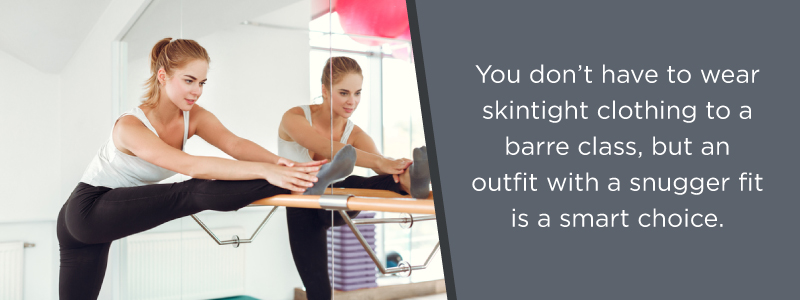
- Sports Bra (Optional): Some women feel more comfortable during a workout in a sports bra, but we leave this up to you. Barre class isn’t too high impact, like running, but it does require you to move around a lot. Feel free to wear a sports bra with moderate support, or skip wearing one altogether. Remember, exercise clothes are about your comfort.
- Pulled-Back Hair: Barre class isn’t extremely fast-paced, but you do have to move your body in a lot of unusual ways. If you have longer hair, bring a headband or a hair tie to keep your hair out of your face.
- A Water Bottle: Just because barre class isn’t high-impact doesn’t mean you won’t work up a sweat. An important part of any workout is staying hydrated. Allow yourself a water break whenever you need one during class.
Don’t worry about bringing any equipment with you. Everything you need to participate in the class, including yoga mats, will be waiting for you in the studio. Come ready to work hard!
2. Stay Mentally Engaged
Physical exercise is good for your body and your mind, according to these statistics:
- After exercising, 53 percent of people report feeling good about themselves.
- A total of 35 percent of people say they are in a good mood after exercising.
- Thirty percent of people say they are less stressed after exercising.
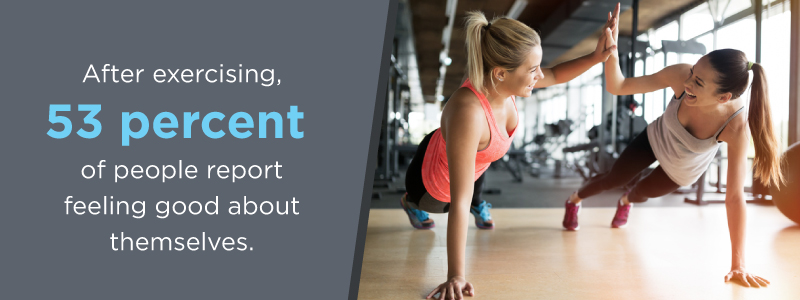
Exercise can be challenging, but staying engaged is the best way to get the benefits from that challenge. Try to keep your mind focused on what your body is doing. If you let your mind wander during barre class, you might miss out on some of the benefits.
Barre class is inspired by ballet, but you don’t need to be a dancer to come to class. While you can learn how to do each exercise in barre class, you might not be familiar with the terms your instructor uses. Be sure to stay tuned in to everything the class leader says so you don’t miss the names of the exercises and the accompanying instructions. If you stay mentally engaged, you’ll learn what “relevé” — standing on your toes — and “tuck” — tilting your pelvis — means in no time.
If at first you feel confused and out of step with the rest of the class, don’t get discouraged. Any new form of exercise has a learning curve. Keep an open mind and focus on what your instructor is saying.
Going through the movements in barre class isn’t enough. Barre class focuses on working specific groups of muscles you probably don’t use on a regular basis. This means you need to position your body in a specific way and move it in a precise way. You might think you’re moving just like everyone else in the class, but if you aren’t listening closely to your instructor’s cues, you could be cheating yourself out of the full intensity of the exercise. Making even small adjustments to your form can make a big difference.
Another key part of mental engagement is being attuned to the way your body feels and pushing yourself to embrace the challenge. Barre class helps you improve your strength, flexibility and balance while working your core and giving you a cardio workout. That’s a lot going on with your body at once — and you’re going to feel it.
Don’t be scared to push your muscles to the point of burning, but listen to your body. If you need a brief break during your first class — or any subsequent classes — that’s perfectly fine. Grab a sip of water and prepare your mind and body to jump back in.
3. Don’t Be Afraid to Shake
Barre class is designed to work muscles more than we normally do. You’re going to be using your arms, legs, glutes and core throughout the class. As the class goes on, you might notice your arms or legs starting to shake. Your first reaction might be embarrassment. Are you that out of shape? Why is this happening?
Forget about being embarrassed. Any barre instructor will tell you shaking is a great sign. This means you’re following their guidance, working the right groups of muscles and reaching the right level of intensity. Muscles we don’t use all time aren’t used to this type of focused, intense exercise. If you’re doing barre class right, the muscles are going to work to the point that they start to burn and shake.
Barre class has a slower pace, which focuses on holding positions for longer periods of time. Don’t let the slower pace trick you — your muscles are still being challenged. While workouts at a faster pace sometimes give your muscles a break between movements, this isn’t the case with barre. You’re giving your muscles some serious endurance training.
If you get to the point that you feel the shake is uncontrollable, take a moment and stop. Grab a sip of water and stretch out the muscles in question. Even people who are barre class regulars deal with shaking. The more regularly you attend class, the less intense it will become.
If your legs don’t shake, but your instructor tells you your form is great, don’t worry. Everyone’s body is different. Focus on yours and how it reacts to the exercises.
4. Realize You’re Working New Muscles
You’ve probably heard people love barre class because it helps you achieve a lean dancer’s physique. Everyone’s body type is different, but you hear this because the movements in barre class help you achieve strong, lean muscles.
When you watch someone else go through the various poses in barre class, it will probably look like they are not doing a whole lot of moving — that’s because barre class relies on isometric movement. During an isometric exercise, you use your muscles to hold a single position without moving. It might sound easy, but it actually challenges your muscles. Holding them in one position for an extended period of time can lead to that shaking many people experience in barre class.
Holding a plank is a great example of an isometric exercise. You work your arms, legs and your core, but your body is completely still.
A dancer’s physique radiates strength, and one of the most obvious benefits of barre class is improved strength. The exercises focus on muscles that often get ignored during other workouts. Expect to feel the burn in places like your glutes and hamstrings. Exercises that incorporate weights are also great strength building tools.
When we imagine someone with a lean and lithe dancer’s body, we often think about how flexible that person is. Barre class is a great way to improve your flexibility. The exercises in barre class involve a good amount of stretching that will help you gain a greater range of motion over time. Greater flexibility helps relieve muscle tension and improve your overall balance and coordination.
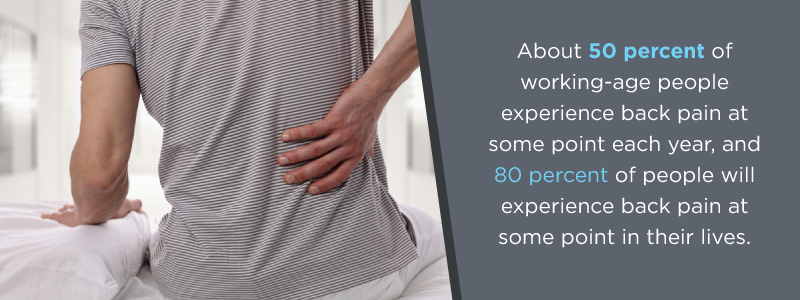
Dancers are noted for their excellent posture. About 50 percent of working-age people experience back pain at some point each year, and 80 percent of people will experience back pain at some point in their lives. One of the leading causes of back pain is poor posture, and barre class has many exercises that will help improve your posture. Most poses require you properly align your spine and shoulders, and then you have to hold that position.
Barre class is going to work muscles you hardly ever think about. Prepare to feel tired and sore from head to toe. Remember that is a good sign!
5. Head Back to Barre Class Within 48 Hours
You might want to give those sore muscles a break after your first class, but it’s important to get back to barre within two days. You’re probably going to have a lot of lactic acid, which is causing those sore muscles. If you commit to a regular exercise routine instead of working out occasionally, you’ll notice that sore feeling less and less. Push yourself to return and build a healthy exercise schedule.
It can be easy to talk ourselves out of exercising. Maybe we tell ourselves the work day was too long and stressful, or that we’d rather sleep in than get up for an early-morning barre class. To avoid falling into that trap, sign up for your second barre class ahead of time. You’ve set aside the time and paid for the class. It is going to be a lot harder to talk yourself out of going after that.
Once you’re onto your second class, you can feel a little more relaxed. You know what to expect. The names of the exercises, what the equipment looks like and what’s expected of you aren’t completely new anymore. You’ll still have plenty to learn, but you have a great starting point.
For your second barre session, you can take the same class or try something new. Play around with the available classes and the different instructors to find the right fit for you. Once you’ve found your ideal class and instructor, you can create a schedule and stick to it. Eventually, your instructor will become familiar with you and push you to challenge yourself even more. You’ll start to feel the benefits of barre class in no time!
Barre Before and After
Become the star of your own barre workout before and after photos and schedule a class with Physique 57 online. We have studios in Bangkok, Dubai, Mumbai, Indianapolis IN, and New York City. If you don’t live near a studio, you’re welcome to work out with us virtually. Sign up for a free trial of our online barre classes.

